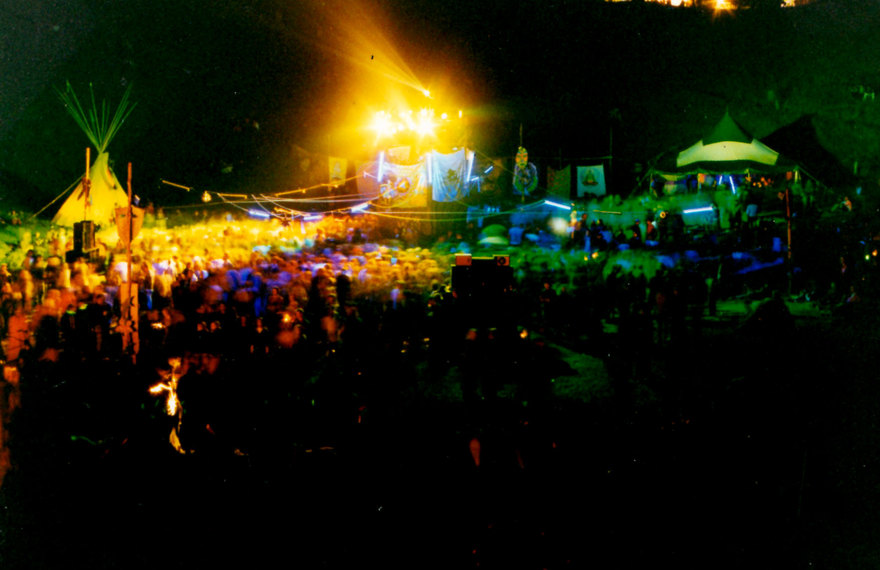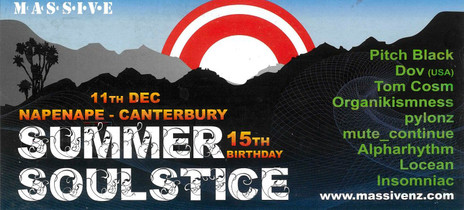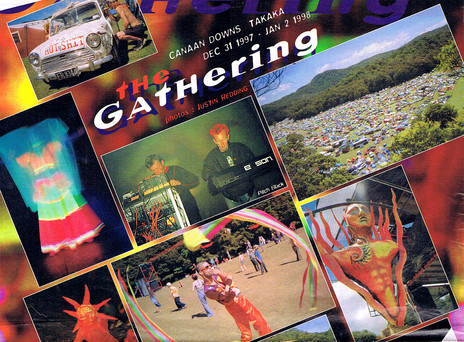
Pitch Black: Mike Hodgson and Paddy Free performing at The Gathering 98-99. - Mike Hodgson collection
Every summer, thousands of New Zealanders gear up for outdoor EDM events, where they pitch tents and dance for hours on end in scenic locations. Now dominated by licensed commercialism, they’re a rite of passage, but I can guarantee that on every dancefloor you’ll find some colourful, barefoot, OG ravers boring the Zoomers about how at The Gathering you bought your stimulants weeks in advance, and hid your booze, because alcohol was banned. Te Waipounamu was the home of 1990s and 2000s raving; not just at Canaan Downs, but across the South Island, scores of events were held by committed volunteers who did everything, including making them a (mostly) safe space. Dancers will have their own favourites, but here are a few of the halcyon unlicensed raves where there was no such thing as inclement weather, and you were more likely to encounter a giant frog than a pesky drunk.
1. Entrain, Canaan Downs (1992-1995)

Entrain, Tākaka Hill, New Years Eve 1993-94
The fabled Entrain parties were started in 1992 by a big crew of folk who’d returned from their Overseas Experience of the acid and ecstasy-fuelled European rave culture. They decided to DIY it (complete with fire poi) on Canaan Downs, Tākaka Hill – a venue chosen for vibe over easy accessibility. Six hundred people were at the first New Year’s event, and 3000 at the last – where Salmonella Dub headlined – but I was way too uncool to be one of them. Instead, I’ll quote my mate Simon Kong, one of the tech crew: “Entrain was a spiritual fizz bomb, a cultural kick-start for a burgeoning scene ... The Entrain parties launched us on a spiral course, where we swam like cosmic babes towards a burning flame of consciousness. In this social soup we arrived together to dance in the centre of our very own universe.”

The Entrain dancefloor, New Years Eve 1994-95
2. Sign of the Bellbird, Port Hills (1994-ongoing)
The Sign of the Bellbird is a 1914-built stone “rest house” just off the Summit Road. Easily accessible, and featuring a fireplace and views of the Alps, it’s probably hosted more raves than picnics, with so many Christchurch crews using it over the years. I was a tad too old to know about the early events, but some of those ravers are now friends (who remember enough for a whole other article). The Sign of the Bellbird was where many of the drum and bass, techno, house, and dub producers that the city is known for began. Marbles was one such event, and fortunately, photographer Marc Rosewarne was there, and has put together a montage of pix, that induce serious KIMO (knowledge I missed out). The Bellbird still plays host to renegade parties, introducing dance culture to yet another generation, 30 years after the first raves. Some legacy.
3. The Quickening, Port Hills (December 1995)
The Quickening is another notable mid-1990s Port Hills event, for which there is online evidence of how much fun an underground rave can be. The flyer includes a landline number for extracting the “exact venue details” on the day, but it also notes that it was held to celebrate “the ending of yet another superb CH-CH rave season”, indicating just how busy the crews were that year. If you were there, then lucky, but if you’re a fellow KIMO you’ll still enjoy this clip of Marc Rosewarne’s photos, which includes babyface pics of a cohort of pivotal Ōtautahi DJs and producers, including: Pylonz, Oakley Grenell, Solid State, OB1, and Presha. Top billing was both Auckland’s Riddle and drum and bass in general, but the location was also a star, with dancers cutting shapes throughout the day and night against a backdrop of a Christchurch skyline that no longer exists.
4. Eudaemony, various Otago locations (1995-2000s)
Dunedin had the Eudaemony tribe, famous for its winter solstice celebrations, the dates of which dictated when MASSIVE held ours so that we could attend. The brass monkey of parties, there were woollen coats and kilts aplenty, ditto magic mushrooms, and the DJs were hidden so that dancers faced each other. Most memorable was the 2003 one at Seacliff, a former mental asylum they had been partying in since 1995, but thankfully this one was held outside on the grounds. Coinciding with a particularly good shroom season, I vividly remember the full moon emerging from cloud and lighting up the ruins (which I’d forgotten about) and thinking how lucky we were to express our raving madness in such a wholesome way. Later a couple – wrapped together in a sleeping bag – rolled across the dancefloor, their giggling causing a Mexican wave of laughter, any lingering autumn melancholia disappearing in its wake.
5. M*A*S*S*I*V*E, various Canterbury locations (1996-2017, whānau parties still take place)

Massive Summer Soultice flyer
In 1996 some mates who wanted to get out of their heads – and later, the city – started Christchurch’s MASSIVE, a trust with a revolving crew of volunteers who put on numerous events for over two decades, including the quarterly Equinoxes and Soulstices. Travelling in all directions to a paddock or reserve with a view, the Unimog with the sound system, someone else with the generator, and Callum with the Portaloo trailer, organisers and participants would assemble. By nightfall, dancers were treated to a lushly lit and decorated playground, featuring a progression of genres until the next day. From the modest one-zone parties nurturing producers such as Tom Cosm, to post-quake events with added D&B zones for the nightclub-less, the MASSIVE volunteers put up with every weather imaginable – including a Nor’West dust storm and a frozen dancefloor – to cater to Cantabrians bonkers enough to experience four seasons of outdoor dancing. Sadly missed.
6. Initiation to Destination, Cave Stream (1996-2004)
At another site chosen for vibe over accessibility, Initiation was started by Steve Willis in 1996, who recognised the towering limestone outcrops of Te Kōhanga (Castle Hill) as perfect for dancing on – even if you had to lug your gear across a valley. Initiation evolved annually through Tranceformation, Trancemission, and Trancefusion, becoming Destination in 2000 to acknowledge increased musical diversity, including: The Nomad, Shapeshifter, Salmonella Dub, Fat Freddy’s Drop, Trinity Roots, and Richard Nunns. Featuring laser displays on rock faces, these were the parties I knew – probably because you could now drive in, albeit on a track kinder to the “hippie” vans than the low rides the D&B kids drove. Even when the wind blew the stage away and a Portaloo over (door down), thanks to the venue, line-ups, and people, every one of those parties was special – and many of us miss them even more than the Gathering.
7. The Gathering, Canaan Downs/Cobb Valley (1996-2002)

Poster for The Gathering, 97-98. - Photos by Justin Redding as they appeared in Rip It Up. Mike Hodgson collection
The transformative properties of The Gathering are well documented, and I found the 1998/9 event so life changing I ended up as a “raveologist”. In my review for The Press, I was taken by the seven zones “pumping out dance music”, along with the performers: “weird and wonderful looking individuals [that] turn up where you least expect them. The lines between imagination and reality are blurred when a mime artist “hauls” in the line made by a light cutting across the dark, or an iridescent frog squats realistically at the entrance to one of the dance zones.” What I omitted was that my bestie and I were so high that we debated for ages whether that giant frog outside the dub zone was real, no doubt to the frog’s amusement. That was the Gathering – there to free your mind and mess with your head.
8. Visionz, Golden Bay (1998-2004)

Visionz music festival, Golden Bay, 2002. Watch more here
A Golden Bay New Year’s festival run by the Tākaka-based sustainability trust Visionz, this event was more family-oriented than the gleefully hedonistic raves. There were health and environmental workshops, vegetarian food stalls, and the organisers promoted a “leave no trace” ethos (which not all dancers could manage). I attended the final Visionz at Pākawau and was particularly taken by the gorgeous native bush setting, and the DIY squat toilets featuring carnivalesque slogans celebrating pissing and shitting. The event had several zones, a river and the beach nearby, and live bands were enjoyed by the dancers not quite so entranced with trance. Honouring the Pagan spirituality that had long permeated the outdoor dance zones, Visionz 2004 also featured the first Aotearoa Burning Man ceremony (before it became Kiwiburn), where organiser Mark Stirling led a parade of drummers, dancers, and fire jugglers before setting the towering Man alight. Good family fun.
9. Wonderland, Pleasant Point (2002)

Wonderland 2002: Minuit, Far Freddy's Drop, Nomad, MC Antsman
Before writing this, I was sure Wonderland was the first time Fat Freddy’s Drop played in Te Waipounamu, but after a fellow attendee questioned that memory, I wondered if it was just a DJ dropping ‘Midnight Marauders’. The band weren’t sure either, but thankfully a party archivist mate has flier evidence that Minuit, Nomad, and FFD all played. Other memories include: descending from the camping paddock to the sparkly party through a cave featuring some of the area’s (roped off) Māori rock art; gesturing at Nomad to please play ‘Movement’; and that after it ended, a group of sheep wandered in, but were chased out again by a large mirror ball being lifted off a tree by a gust of wind, much to the delight of the straggling rinsers and stoners. Wonderland only happened once, but it truly encapsulated the ephemerality of those parties, and utopia should always be fleeting.
10. Luminate, Canaan Downs (2008-)
Back to Canaan Downs where The Luminate Festival Trust will host the pagan fire Festival of Lunasa 2024 (1st to 5th February), making this event one you can attend! Luminate began in 2008, but I was taking a post-thesis break from parties, and later was busy with my own event recycling business. So I’ve never been, but I hear it fulfils my dream of a non-commercial, sustainable outdoor festival. Attendees become co-creators, and a large volunteer crew provide the mahi. The Trust is part of the Canaan Downs Collective that purchased the site in 2011, so they use it as an educational example of permaculture in action, including composting toilet waste, and shunning disposable anything. Last time I was on that legendary dancefloor, I was picking up glitter foil, so perhaps it’s time I got my arse back up there to dance on ground where we leave only our footprints.
--
Dr Sharon McIver was awarded a PhD in 2007 for her thesis WaveShapeConversion: The Land as Reverent in the Dance Culture and Music of Aotearoa